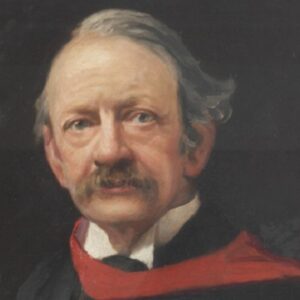J.J. Thomson was an English physicist and mathematician. Thomson was a child prodigy who first went to college at the age of 14 and maintained his journey to become one of the most accomplished scientists of his generation. Thomson became the Cavendish Professor of Experimental Physics at the University of Cambridge at a very young age but he made his greatest achievement when he did a detailed study of cathode rays and proved the existence of the electron in atoms; that would go on to have far reaching effects in the study of the natural sciences. Thomson also presented lectures at some of the best universities in the world like Princeton University and Yale University as a guest which further cemented his reputation as a scientist of uncommon gift. Other than the Nobel Prize in Physics, Thomson went on to win numerous other notable prizes throughout a career that yielded scientific breakthroughs that would affect scientific research for many years.
Childhood & Adolescence
Joseph John Thomson was born on 18 December 1856 in the Cheetham Hill district of Manchester, Lancashire, United Kingdom, to Joseph James Thomson and his wife Emma Swindells. His father was the proprietor of an antiquarian bookshop. J.J. Thomson was the elder brother of one.Thomson was something of a child prodigy due to his early mastery of the sciences. He was admitted to Owens College in 1870, at the age of 14.Thomson received a place at Trinity College, University of Cambridge, to study mathematics in 1876, at the age of 20.
He earned his bachelor’s degree with first class honors four years later and was one of two students to be awarded the Smith’s Prize, which is given to students of mathematics and theoretical physics who are actively engaged in research.He was elected a Fellow of Trinity College in 1881 and received his MA from Cambridge University two years later. Thomson was also awarded the coveted Adams Prize, which is presented by Cambridge University to those who have made remarkable contributions to research.
Thomson began his career at Trinity College, University of Cambridge, where he further cemented his status as one of the world’s most outstanding mathematicians. Thomson was elected a member of the Royal Society in 1884, and by the end of the year, he had been appointed Cavendish Professor of Experimental Physics at the University of Cambridge.His early research focused on the structure of atoms, and his first published paper was titled ‘Motion of Vortex Rings,’ in which he employed pure mathematics to describe William Thomson’s vortex theory in relation to atomic structure.
Thomson’s early research focused on mathematical explanations of chemical processes, culminating in the 1886 publication of ‘Applications of Dynamics to Physics and Chemistry’. He released ‘Researches in Electricity and Dynamism’ six years later.In 1896, he was invited to conduct lectures at Princeton University on the issues on which he had worked. The lectures were fully covered in the next year’s book ‘Discharge of Electricity via Gases.’
He began the most significant original study of his career in 1897, when he began his foundational research on cathode rays, which led him down numerous alleyways and culminated with the discovery of the electron in connection to atoms, which forever altered the face of natural sciences.He demonstrated the structure of an atom and also elucidated the various concepts of electricity in a series of lectures held at the prestigious Yale University in 1904. Thomson also argued that positive rays may be utilized to split atoms.
He spent the latter portion of his career pursuing research on isotopes, which resulted in the discovery of positive ions. He later made significant discoveries such as the radioactivity of the element potassium. On the other hand, he was able to demonstrate that hydrogen possessed only one electron.
His Significant Works
J. J. Thomson’s most significant work was on the research on cathode rays that resulted in the discovery of the electron, for which he was awarded the 1906 Nobel Prize in Physics.
Awards and Accomplishments
Thomson was a recipient of the Royal Medal in 1894.In 1902, the Royal Society of London presented J. J. Thomson with the Hughes Medal.In 1906, he was awarded the Nobel Prize in Physics for his work on the electron’s discovery.
In 1910, the Franklin Institute awarded him the Elliott Cresson Medal, and 12 years later, the Franklin Medal.The Copley Medal was presented to him by the Royal Society in 1914, and the Albert Medal was presented to him by the Royal School of Arts a year later.Thomson was appointed a ‘Master of Trinity College’ in 1918.
Personal History and Legacies
In 1890, J. J. Thomson married Rose Elisabeth Paget. They had two children: George Paget Thomson, a son, and Joan Paget Thomson, a daughter. The son later became a Nobel laureate physicist.He died on 30 August 1940, at the age of 83. His remains were interred at the illustrious Westminster Abbey.
Estimated Net Worth
Joseph is one of the wealthiest physicists and is included in the list of the most popular physicists. Joseph John Thomson’s net worth is estimated to be at $1.5 million, based on our analysis of Wikipedia, Forbes, and Business Insider.He studied at the Victoria University of Manchester, the University of Manchester, the University of Cambridge, Trinity College, and the University of Manchester.


